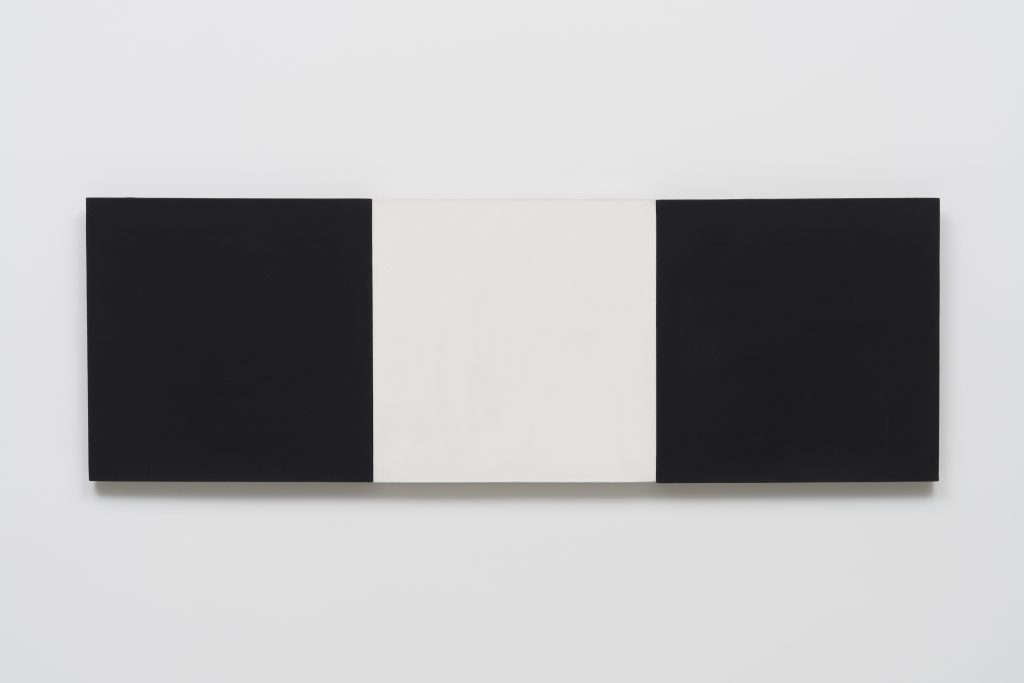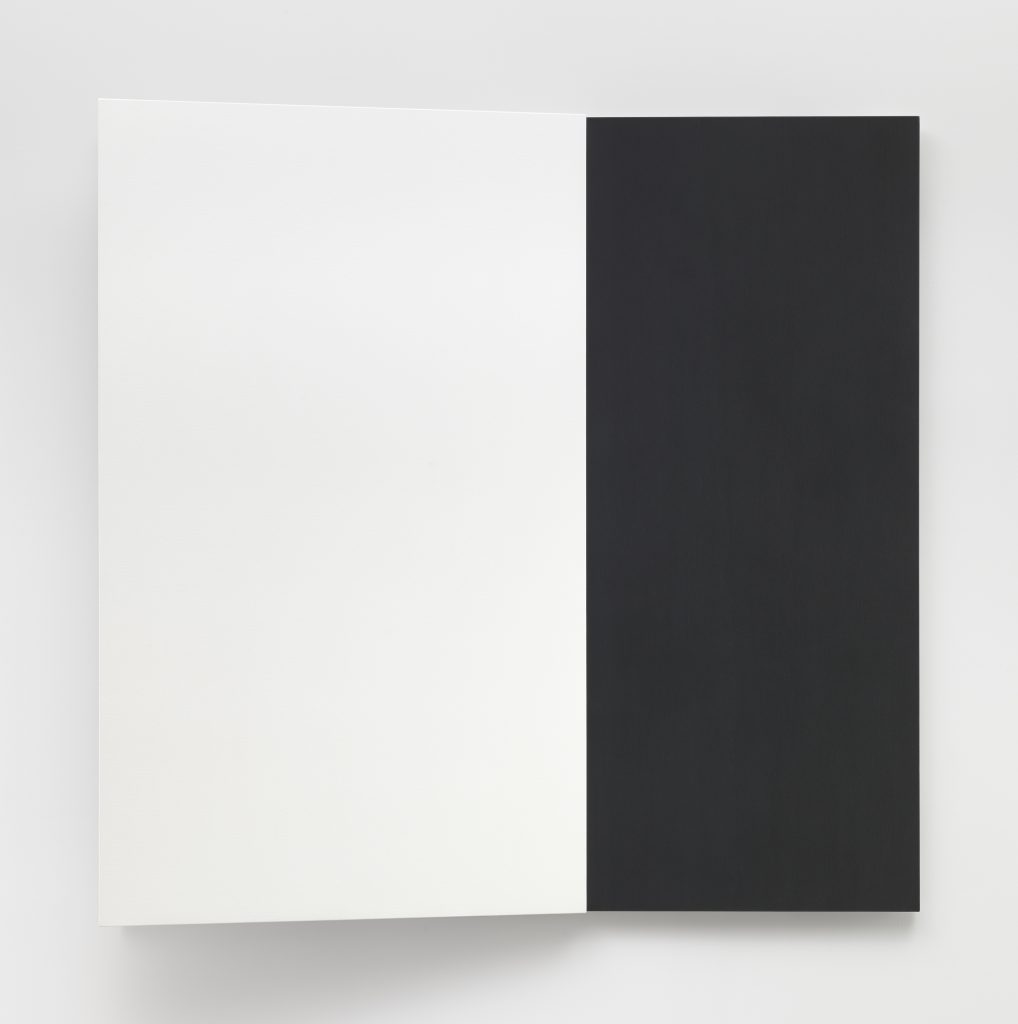I am perpetually enamored by the artwork of Ellsworth Kelly, and I was thrilled to learn that Matthew Marks Gallery was hosting a new, solo exhibition of the renowned artist, who lived until 2015. The currently open showcase, at a New York City space of the gallery’s, focuses on artwork incorporating black and/or white alone and is titled accordingly: “Ellsworth Kelly: Black and White.”
Ellsworth Kelly at Matthew Marks
Arriving, I stepped into a physically manifest meditation on spatial — and, I also imagine, interpersonal — relationship. The stark contrast of the black and white outlined this exchange, and though the amounts of each color category in the individual artworks varied, the feeling across the entire exhibition was nonetheless fairly consistent: an even-keeled, steadily progressing, give-and-take in which one side of the aesthetic and evoked experiential spectrums sung in unison with the other.
It was a cohesive togetherness drawn from the outlining of space itself, whether within the context of the artwork or an invoked, real-world parallel. It was spatial presence, as the black and white tended to invoke in my perception, made into something grounding, enveloping, and defining.
In the straightforward, striking nature of Kelly’s forms sitting within this progressing framework, the briefest snippets of perceived space — a corner, or a flow of light across a wall — felt melded into the broadest, most overarching perceptual reckonings of space. It was grandeur — considering the rather forcefully sweeping scope of these pieces — that existed outside of its initial self from the get-go. The non-specific nature of Kelly’s forms cracked open a shimmering cascade of possibility and experience in each instance.
Each artwork and the exhibition as a whole were a study in contrasts that culminated into a feeling of inwardly driven unity, like the balance between confrontational but stable force and propulsive sprawl in a series of ocean waves. The shaping of each area of color combined with the stark consistency of its application left every artwork with a towering impression, but it was all something also welcoming and synchronous. This art is something massive — again invoked by the sheen of this exhibition’s color palette in particular — that also coasted smoothly.
The expanses of color, richly enveloping — while, from one viewpoint, nondescript — operated like a subtext to recognizable, lived experience of both the natural world and our built environments, in which one might say that we do, as individuals, conceptually/metaphorically merge into our environments both small-scale and much larger. And Kelly finds a beauty in it, something elevating and rejuvenating.

Turning Shadows into Something Bigger
Kelly’s art, though often straightforward and, on its own, non-specific in its forms, frequently hearkens to the visual and tangible components of the natural world and experiences of it, and that continues here.
It’s easy to imagine “Black Curve II” (1972), for instance, as a growing shadow, and the weight of the shadowy area that spreads across the surface of the oil on canvas-work is left manifest. It’s this moment and every other one created or evoked by Kelly’s art brought to its fullness, and in turn, that fullness of feeling, expression, and experience found just about everywhere: each presence, cultivated and entire.
The quiet but monumental nature of Kelly’s areas of color combines a moment of perhaps even isolated perception — standing alone against the force of nature or, in these artworks, shadow and light — with a feeling of wholeness and of resolution. There is rarely if ever any sense of strict, spatial progression: one point moving to the next point, and so on, instead insisting on carefulness and serenity even on the most overarching of levels: co-existent intermingling.
Time and again, a depicted form arises and sits, perched in a blissful, grounding shine. It’s an elevation and celebration of something strictly momentary — a flash of light, a wave of shadow, or something on par with those experiences.
In each artwork, whether featuring broad curvature or angular exploration, the visuals build dramatically but slow down, insisting on a vision of even cosmic, astronomic forces evoked by the black and white color palette as individually buoying: a voyage, in each instance, back into itself. The expressive wholeness of Kelly’s forms suggests an expansive, shimmering world of possibility in something improbably light: a breeze, perhaps. Starlight sweeps down with resounding, stark force — and in Kelly’s envisioning, it creates its own ecosystem of experience: presence without sequence or direct, obvious explanation.

The Cosmic, Becoming Something Immediate
Both against Kelly’s artistic reference points in the natural world and considered aesthetically alone, the exhibited artworks cultivated something fleeting — a vast expanse of attention-grabbing light or consuming darkness — into something also graspable and sensory: the visuals of presence. Kelly’s art, both here and elsewhere that I’ve been fortunate enough to see it, tends to use the language of modern art for goals or simply eventual endpoints that feel lofty, ambitious, exploratory, and uplifting — truly adding to our most acutely perceived experiences of the world.
In the art’s insistent, internal weight — furthered by the sensory friction of the black and white, Kelly insists, I think, on presence as something that easily surpasses cause-and-effect, sequential reckoning. Kelly’s art, particularly here with this selection’s utilization of black and white, feels like portraiture of the infinite — and specifically, how that infinite intersects with real areas of tangible experience like those covered by figurative art of history and today.
“Ellsworth Kelly: Black and White” continues through December 21, 2024, at Matthew Marks Gallery in New York.


Featured image: Installation view of “Ellsworth Kelly: Black and White,” Matthew Marks Gallery, New York, November 7 – December 21, 2024. © Ellsworth Kelly Foundation, Courtesy Matthew Marks Gallery
You may also like
-
Diana Kurz at Lincoln Glenn in New York: A Review of a Shining Art Exhibition
-
Dustin Hodges at 15 Orient in New York City: An Ensnaring Exhibition at an Exciting Gallery
-
Maren Hassinger at Susan Inglett Gallery in New York: Reviewing an Uplifting Art Exhibition
-
Enzo Shalom at Bortolami in New York City: Reviewing an Entrancing Exhibition of Paintings
-
“Ben Werther: Townworld” at Amanita in New York City: Reviewing a Richly Memorable Art Exhibition
